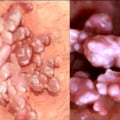Genital warts are a common sexually transmitted infection (STI) caused by the human papillomavirus (HPV). A dermatologist can diagnose them by examining the affected area during an office visit. In some cases, a sample of the wart may be taken and sent to a laboratory for confirmation. These warts can be found on the skin surrounding the genital area, such as the vulva, vagina, anus, cervix, penis, scrotum, groin, or thigh.
They can be raised or flat warts, single or multiple, small or large. Some HPV warts can clump together in a shape similar to cauliflower. Genital warts are usually diagnosed by visual recognition by a healthcare provider, who can use a magnifying glass to find small warts. If external warts are found in a woman, the cervix is usually also examined.
The doctor can use a special solution to help find injuries that do not have the classic characteristics. If you think you have warts on or around your genitals or anus, it is important to have a nurse or doctor examine you as soon as possible. If you develop genital warts and they don't cause any bothersome symptoms, you may not need medical treatment. For women, it is important to have regular pelvic exams and Pap tests, which can help detect vaginal and cervical changes caused by genital warts or the early signs of cervical cancer. You can get tested for genital warts at the doctor's office, at a community health clinic, at the health department, or at the local Planned Parenthood health center. The Foundation for Sexually Transmitted Infections Education (STIEF) provides information and advice on where to seek help for HPV and genital warts.
STIEF is supported by an educational grant through the collective health boards of the New Zealand districts (20) and also by CSL, which contributes to optimization (NZ HPV Project). The New Zealand Ministry of Health supports the use of these clinical guidelines developed by clinical experts and professional associations to guide clinical care in New Zealand.










